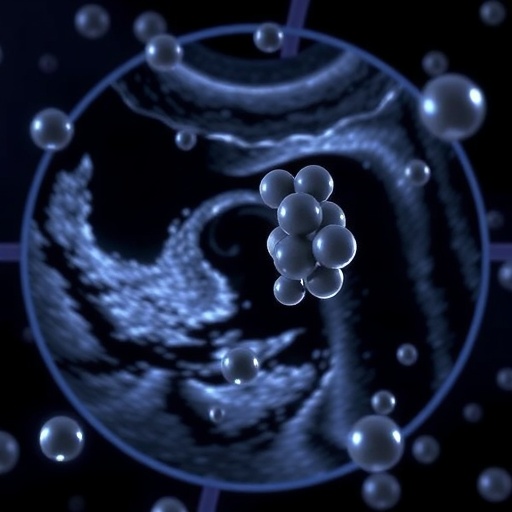In a groundbreaking advancement for the treatment of obesity-related hypertension, researchers have employed an innovative approach combining diagnostic ultrasound irradiation with microbubble technology to target the carotid body (CB) in rabbits. This novel intervention aims to modulate the CB’s activity, a pivotal regulator of sympathetic nervous system output and blood pressure control, offering hope for safer management of hypertension without the drawbacks of traditional ablation methods.
The carotid body, a small cluster of chemoreceptors located at the bifurcation of the carotid artery, plays a crucial role in sensing blood oxygen levels and influencing respiratory and cardiovascular responses. While surgical ablation of the CB has been known to reduce sympathetic activity and lower blood pressure, it carries the significant downside of impairing the body’s ability to adapt to hypoxic conditions, which can be dangerous. The present study pioneers a non-invasive, precision-targeted method that mitigates these risks by using diagnostic ultrasound alongside microbubble contrast agents.
Utilizing a cohort of obese hypertensive rabbits, the researchers meticulously designed an experiment dividing the subjects into three groups: unilateral intervention, bilateral intervention, and a control group without intervention. The rabbits were administered intravenous injections of sulfur hexafluoride microbubbles that enhance ultrasound imaging and facilitate mechanical effects on targeted tissue, followed by continuous diagnostic ultrasound FLASH-mode irradiation directed specifically at the carotid bifurcation for 15 minutes. This innovative synergy was hypothesized to induce localized modulation of CB activity.
Crucial physiological parameters were monitored, including blood pressure (systolic and diastolic), hypoxic ventilatory response (HVR), peripheral chemoreceptor sensitivity (PCS), and baroreceptor sensitivity (BRS). These measures were assessed prior to intervention and again one month post-procedure to evaluate both acute and lasting effects. This comprehensive evaluation helped elucidate how effectively the synergistic treatment modulated CB function in the context of obesity-induced hypertension.
Remarkably, the treated groups exhibited significant reductions in both systolic and diastolic blood pressures when compared to their pre-intervention baselines. The bilateral intervention group demonstrated the most pronounced decrease, with blood pressure dropping more than 10 mmHg relative to controls. Such substantial reductions underscore the therapeutic potential of ultrasound microbubble-mediated CB modulation in managing hypertensive states, especially those compounded by obesity.
Furthermore, the researchers observed a near 50% decrease in hypoxic ventilatory response and peripheral chemoreceptor sensitivity in treated groups, indicating an effective downregulation of carotid body chemoreceptor function. This suggests that the intervention successfully attenuated the CB’s overactive signaling often associated with heightened sympathetic drive in hypertension, a key pathological factor in this condition.
Histopathological examination revealed intriguing insights into the structural impact of the treatment. The carotid bodies in treated rabbits showed signs of injury and proliferation of fibrous tissue, indicating controlled tissue remodeling. Advanced techniques such as TUNEL assay demonstrated varying degrees of apoptosis—programmed cell death—within the CB, confirming the biological impact at the cellular level.
Moreover, immunofluorescence analysis highlighted a notable reduction in the expression of type I and II cells within the CB post-treatment. These cell types are integral to the CB’s chemosensory functions, and their downregulation aligns with the observed functional outcomes of decreased sensitivity and ventilatory response. Together, these findings provide robust evidence of the intervention’s mechanistic effect on carotid body physiology.
Noteworthily, this method leverages the mechanical index of diagnostic ultrasound in a high-intensity exposure mode capable of engaging microbubbles to induce targeted bioeffects without resorting to invasive surgery. This approach benefits from the spatial precision and real-time imaging capabilities of ultrasound, offering a promising platform for future clinical translation that could reduce the burden of antihypertensive therapy side effects.
This study also opens avenues for refining parameters such as ultrasound dosage, exposure time, and microbubble concentration to optimize therapeutic efficacy and safety profiles. The controlled induction of CB modulation without full ablation addresses significant clinical challenges, providing a balanced strategy to decrease sympathetic overactivity while preserving essential physiological functions.
In summary, the successful application of diagnostic ultrasound irradiation combined with microbubble contrast agents introduces a powerful non-invasive technique for modulating carotid body activity. Its demonstrated ability to safely and effectively lower blood pressure in an animal model of obesity-related hypertension marks an important step toward novel hypertensive therapies, shifting paradigms from irreversible tissue destruction to finely tuned functional modulation.
As hypertension continues to afflict a significant portion of the global population, with obesity as a major risk multiplier, novel interventions like ultrasound-mediated CB modulation hold immense promise. Future research will need to focus on long-term outcomes, potential translational challenges, and comparative effectiveness against existing pharmacological and surgical treatments.
This innovative approach exemplifies the intersection of engineering and biomedicine, harnessing physical principles and advanced imaging tools to tackle complex clinical problems. Should subsequent studies confirm safety and efficacy in humans, this technique may revolutionize hypertension management, reduce reliance on medications, and improve quality of life for millions worldwide.
With expanding applications, the synergy between microbubble technology and diagnostic ultrasound is poised to redefine therapeutic possibilities—ushering a new era of precision medicine that targets disease mechanisms at the cellular and molecular levels with unprecedented control and minimal invasiveness.
Subject of Research:
Article Title:
Article References: Jiang, X., Yu, W., Chen, Z. et al. Diagnostic ultrasound irradiation combined with microbubbles to modulate carotid body activity for the treatment of obesity-related hypertension in rabbits. BioMed Eng OnLine 24, 126 (2025). https://doi.org/10.1186/s12938-025-01451-z
Image Credits: AI Generated
DOI: https://doi.org/10.1186/s12938-025-01451-z




